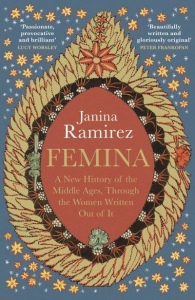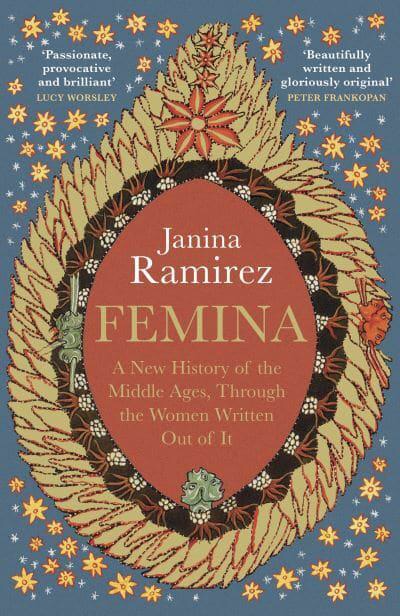
This book sure stood out from afar on the shelves of the Edinburgh Book Festival last summer. I took a closer look at its lavish gorgeousness. Then I left it on the shelf because if that is what I think it is on the cover, that is a pet hate. Even though Femina is a history of how women were ignored and held back because of their sex, the stylised vagina on the cover “don’t impress me much.”
Rant (which will probably sell a few copies) over. Let’s move on.
Nonetheless, because of my amateur and casual interest in medievalism, I listened to the audio book, narrated by the author herself, and bought the e-book when it came on offer. It’s probably going to be the best 99p I spend this year. The contents of the book are as fascinating as I hoped they would be.
Ramirez starts surprisingly with the story of Emily Wilding Davison, the suffragette who fell under the king’s horse. This is because some suffragettes, and Davison was one, did not see themselves as breaking new ground. They believed they were attacking a recent phenomenon of oppression. That the misogyny of the Edwardian period was a modern thing. They understood the medieval period to have been populated by powerful women. Not just Eleanor of Aquitaine and Joan of Arc of whom we are all aware. Ramirez’s book is dedicated to bringing the stories of other women back into our historical consciousness.
In 9 chapters, she focuses on, for example the movers and shakers, the warriors and leaders, the entrepreneurs and influencers. Each chapter begins in the present day, often at an archeological site, before moving back in time to conjure up the time and the life of the female subject at the heart of the chapter. For example:
Welcome to Seventh-Century Loftus
The salt air bites your skin as you look out over the choppy waters of the North Sea. … Turning your back on the water and looking inland, a strange terrain unfolds. There are lumps and bumps across the earth, the echo of great buildings many centuries old. Stones from old Roman structures are scattered around, and a couple of new wooden edifices rise up between burial mounds and raised ditches.
Thus transported, the reader becomes witness to a medieval funeral before Ramirez analyses the contents of grave 42, the remains of the burial bed and the jewellery found within. This was the grave of the Loftus Princess, and her pendant, the Loftus Pendant, reveals much about not only her status but also the arrival and spread of Christianity in Britain. Traditional history would have us believe that men did all the work but Ramirez shows that they couldn’t have succeeded without the patronage of powerful women.
Each chapter moves forward in time: Chapter 2 welcomes us to eighth-century Mercia; the archaelogical lesson teaches us about the secrets we can glean from coins, and the power of the abbess Cynethryth. Alfred burns the scones and the ninth-century queens of Mercia fully engage in a game of thrones. Chapter 3 and the Vikings are here. Turns out the warriors aren’t all male. Chapter 4 and lessons are to be learned from the Bayeux tapestry and the women who embroidered it. Chapter 5 starts with the kidnapping of Hildegard von Bingen’s Riesencodex from the soviet sector of Berlin in 1948 in order to return it to the Rhineland. We are then taken to Hildegard’s monastery in twelfth-century Disibodenberg, where she is writing these texts about theology, science, music and art paving the way for the Renaissance and the Age of Reason. Chapter 6 is particularly fascinating. It’s time to visit the Cathars in thirteenth-century France and Esclarmonde de Foix who ruled as regent from 1204. When presenting on Cathar beliefs she was once told by a Catholic male representative “Go, Madame to spin your distaff. It is not appropriate for you to speak in a debate of this kind.” Of course, when the persecution of the Cathars as heretics began, the circumstances of women were reduced even further by the orthodox church as demonstrated by the experiences of Arnaude de Lamothe on the run. Chapter 7 and its time to meet the one and only female king (yes, you read that right) of Poland. King Jadwiga rules in fourteenth-century Kraków. It’s an astonishing story. I’ll leave you to discover it for yourselves. Chapter 8 brings us to King’s Lynn and a woman who has not allowed herself to be forgotten or written out of the history books. That’s because she wrote her own biography and it survived: the inimitable Margery Kempe. The final chapter changes tack, moves away from elites and looks at the diversity within the working classes. The starting point is a burial site of plague victims near the Tower of London which leads to the discovery of the skeleton of a black woman. What? Turns out the crusades had an unexpected impact, with Muslims and Jews moving to Europe, even to Britain. Of course, they bore the brunt of blame for the Black Death …. This chapter also explores the subject of gender fluidity in those times, primarily through court papers regarding a certain John / Eleanor Rykener. Again I’ll say no more. Read chapter 9 for yourselves.
Nay, read the whole book. It is accessible, engaging, enlightening, Raminez makes her point well. Don’t believe for one moment that the women featured are singular cases. There were more of their ilk, just that their historical records have not survived. Whether purposefully destroyed or through natural attrition who can say? Probably both, but what is evident from Jamirez’s work is that western medieval society was not necessarily the cage for women that many of us imagine it to have been.

Oh, this sounds good! I enjoy Ramirez’ programmes on TV, so I think I might be a good candidate for her books too!
LikeLike
I’ve had this on my NetGalley shelf for too long and need to actually read it! I will save your review for when I have …
LikeLike
It’s true, I think it was really the Victorian’s that closed the cage door!
LikeLike